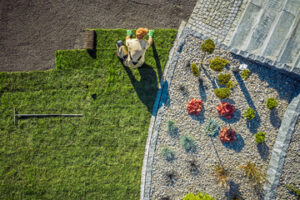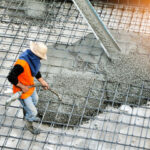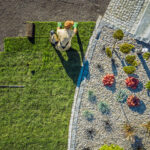Home » Posts tagged 'sod & turf'
Tag Archives: sod & turf
Landscaping – More Than Just Curb Appeal
Landscaping Greensboro NC is more than just curb appeal or “keeping up with the Joneses.” Well-planned and expertly executed landscaping increases property value, provides functional outdoor areas, and reduces maintenance.

Plants provide color, texture and movement in the landscape. Using plants as barriers helps define space and block views, while providing shade and visual intrigue.
Landscapers use a variety of plants to create aesthetically pleasing outdoor spaces. They also use hardscaping elements like paths, patios, and retaining walls to add structure to the landscape. The most important aspect of landscaping is choosing plants that suit the climate and soil conditions of the site. Native plants are often a good choice, as they are adapted to local environmental conditions and can help support wildlife.
A well-designed garden will enhance a home’s beauty and increase its value. It will also provide privacy, protect against wind and noise, and reduce energy costs by shading windows and doors. In addition, a properly maintained landscape can improve air quality by removing pollutants and carbon dioxide from the environment. It can also create habitats for birds and other wildlife.
People value green space and time spent outdoors immensely; perhaps more than they realize. Many cities have parks and other public green spaces that serve a multitude of purposes, from recreation to rest to meditation. Without the work of landscaping professionals, these green spaces would quickly become overgrown and unappealing.
For businesses, sustainable landscaping can reinforce a company’s commitment to environmental stewardship. It can also attract eco-conscious customers and employees.
The most common way that landscaping improves the quality of life is through the creation of green spaces and gardens, both residential and commercial. The practice of creating beautiful, functional outdoor spaces is not a new concept; it has been around since ancient civilizations began manipulating the land to cultivate crops and create gardens. Modern technology is now being used to make the landscaping process even more efficient and environmentally friendly. For example, smart-lighting systems can automatically turn off lights when a space is not being used, reducing energy consumption and eliminating waste.
Water
The tranquil sounds of a serene pond or the soothing sight of a gentle stream can transform your backyard into an outdoor oasis. The beauty of a water feature can also add value to your home if you decide to sell in the future. Current real estate trends show a growing demand for homes with backyard retreats that offer relaxation, entertainment, and connection to nature. Water elements add value to your property and make your backyard a unique place that will stand out from other listings in the neighborhood.
Adding a water feature to your landscape offers boundless opportunities for creativity and design. From traditional options like ponds and streams to contemporary designs such as fountains and bubblers, water features are dynamic focal points that add sophistication to your landscaping. Customization allows you to create a one-of-a-kind feature that matches your aesthetic and complements the existing landscape design of your home.
Aside from their visual appeal, water features have a number of health and wellness benefits that can improve your quality of life. The sound of running water is soothing and has been shown to lower blood pressure and heart rate, reducing feelings of stress and anxiety. Water features can also provide a natural habitat for birds and other wildlife, making them a wonderful addition to your backyard.
The type of plants and trees you choose can significantly impact how much water is used by your water feature. Plants that are native to your area or drought-resistant help decrease the need for excessive irrigation, preserving natural resources. You may also consider incorporating water-wise features into your design, such as rainwater harvesting and graywater reuse, to further reduce your water usage.
Lighting
A well-lit landscape is one of the best ways to increase your property’s value. It can showcase the architectural details of your home, the vibrant colors of your flower beds and garden, or the grandeur of your trees even after sunset. The addition of lighting also makes your space safer for guests who want to walk around after dark. Properly placed lighting can clearly mark pathways and stairs to prevent tripping and falling, and deter unwanted visitors by illuminating areas that could potentially be used as hiding spots.
The style of the lights you choose should be consistent with the design aesthetic of your landscaping and home, ensuring that they look cohesive and intentional at night. Lights can be installed in a variety of ways, including silhouetting (where the light is angled in front of an object to create a shadow effect), uplighting (to highlight the height and structure of trees or other features), and washing (where the light is positioned underneath objects to produce a soft, moonlit glow).
In addition to creating a beautiful ambiance, lighting can help to protect your investment by deterring unwanted intruders. Motion-activated lights can be used to brighten walkways and entries as soon as they detect movement, helping to keep trespassers and vandals at bay. The addition of lighting also makes your home more appealing to prospective buyers, who will appreciate the safety and security features that come with a well-lit landscape.
Finally, lighting options like LEDs are energy-efficient and eco-friendly, making them a great choice for those concerned with reducing their environmental impact. They use up to 85% less energy than traditional incandescent bulbs and last much longer, which means they can reduce your energy costs and maintenance needs over time.
Softscapes
The softscapes are the living, horticultural elements in your landscape that add color, texture, and dynamism. They include trees, shrubs, flowers, grass, and soil. A well-designed softscape can create a tranquil natural oasis that you can retreat to whenever you want to relax and enjoy the outdoors.
Softscape elements also help with the flow and function of your landscape. Pathways and patios make it easy to move around the space, while retaining walls and fences delineate boundaries and offer privacy. Water features and fire pits enhance the ambiance of your outdoor space, while pergolas, gazebos, and arbors provide vertical interest to the landscape and can be adorned with climbing plants.
A properly designed softscape can add beauty to your home while also increasing its value and curb appeal. However, it is important to keep in mind that these elements will need some level of maintenance throughout the year. For example, flowers require yearly replacement and trees need regular pruning. Therefore, it is crucial to include a balanced ratio of hardscape and softscape features in your design plan.
Maintaining a Balance
Softscapes can become a jungle if left unattended. For example, if you have a vegetable garden, rose gardens, succulents, fruit trees, and topiary all growing in a chaotic manner, your backyard will look like a jungle instead of a relaxing place to spend time. To avoid this, you need to have a clear vision of what you want your yard to look like and select appropriate plant varieties.
The contrasting textures of hardscape and softscape elements create a beautiful aesthetic. The right combination of both can take your landscape to the next level and impress family, friends, and neighbors.
Maintenance
After the landscape is designed and built, it needs to be properly maintained to keep up its appearance and functionality. Regular lawn mowing, edging, trimming, mulching, pest control and watering keep the plants healthy, reduce weed growth, promote plant growth and increase overall appearance.
Proper landscaping maintenance also includes hardscapes, such as paths, patios, retaining walls and garden edging. Inspecting these elements for deterioration, damage or dislodgement is an important part of landscape maintenance and ensures that they look pristine. This also helps to prevent costly repairs and replacements in the future.
In addition to enhancing the beauty of property, well-maintained landscaping increases a home’s value and makes it more enjoyable for residents and visitors to spend time outdoors. It’s also been shown that outdoor activities like gardening and yard work can improve mental health and lower stress levels, so it’s no wonder why more people are choosing to live in communities with lush green spaces.
Residential and commercial landscaping has the added benefit of providing a habitat for local wildlife. Incorporating plants that are native to the area helps conserve water and maintain balanced ecosystems. The use of xeriscaping techniques and drip irrigation can also help to reduce water usage and the need for chemical pesticides.
Developing and maintaining a proper landscape requires a substantial amount of time and resources, so it’s essential to plan ahead. Having an organized maintenance checklist helps to reduce costs and ensure that your landscape is functioning at its best all year round. If you’re struggling to convince management to prioritize landscape maintenance, present them with key impact data and visuals that show how a well-maintained landscape boosts customer satisfaction, increases property values and fosters community well-being.
Landscaping – The Art of Outdoor Living
Landscaping is the design of outdoor areas. It incorporates natural elements like plants, lawns and trees with hardscapes such as walkways, patios, fountains and retaining walls.
A landscape can be sculptural or functional. It can provide a play area for children or curb appeal for your home. Visit https://www.landscaping-greensboro.com/ to learn more.

Scale and proportion are important to keep in mind for a balanced look. Repetition is also important for continuity but incorporating new elements on occasion keeps the landscape fresh.
When homeowners think of lawn care, they often focus on aesthetics and property values. However, a well-maintained lawn also provides ecological benefits that extend beyond the boundaries of your yard. Lawns and gardens provide habitat for a wide variety of wildlife, including insects, birds, small mammals and other plants. Using sustainable landscape practices, you can create a healthy, vibrant ecosystem that promotes biodiversity.
The first step in effective lawn care is knowing the type of grass you have. Then you can develop a schedule for fertilization, watering and mowing. In addition, you should know what types of weeds are in your area and how to manage them. If you need to use herbicides, choose eco-friendly options that are less toxic to the environment.
Regular lawn maintenance will help you achieve a healthy, beautiful landscape that is the envy of your neighbors. In addition to mowing and watering, you should regularly test your soil, amend as necessary and use pre-emergent weed control. It is also important to keep records of all your treatments and observations, so you can identify patterns or issues that may require attention.
Throughout warm, sunny summer days, your front and backyard lawns will be on full display for your family, friends, and neighbors. As a result, you want to make sure your lawn is beautiful and healthy so that you can enjoy it all season long.
A well-maintained lawn also helps to improve the quality of your indoor and outdoor air. Grass and other plants act as nature’s air conditioner, absorbing sunlight and reducing the heat that would otherwise reflect off of hard surfaces like sidewalks or driveways. This natural cooling effect can reduce your reliance on artificial air conditioning and contribute to a healthier indoor climate.
If you’re going to take the time to care for your own lawn, start by getting rid of any debris that’s accumulated over the winter. This includes twigs, leaves and dead grass that can suffocate your soil and limit the amount of nutrients that reach the roots. After clearing out the clutter, rake and de-thatch your yard, if needed. Then water it early in the morning, ideally between 4 a.m. and 10 a.m. This ensures that the water soaks into the soil before the sun causes excessive evaporation.
Hardscapes
Hardscapes are the non-living parts of your landscape, such as paved areas, walkways and retaining walls. They can add structure, improve drainage and enhance your yard’s aesthetics. They also provide a contrast to your plants, creating unique textures and adding definition to outdoor living spaces.
There are many different materials that can be used in hardscapes, including concrete, pavers, brick, stone and more. Each material has its own advantages and disadvantages, so it’s important to find one that suits your personal taste. Once you’ve found the right material, it’s easy to incorporate into your design.
Some of the most common hardscape elements are driveways, sidewalks and paths through a garden. However, these can be enhanced with a variety of decorative features to add a personal touch. You can also incorporate natural materials like pebbles and sea glass into your hardscape, which creates a beautiful juxtaposition to the lush greenery of your garden.
Another common use of hardscapes is to add a seating area or gazebo to your outdoor space. These structures can help to define a space for entertaining or relaxing, while providing shelter from the sun and wind. They can also serve as a focal point in your landscape, drawing the eye and helping to create a sense of drama.
In addition to improving the look of your home, well-executed hardscaping increases your property value and can even make it easier to sell. Features like a paver patio, outdoor kitchen or fire pit are in high demand among potential buyers and can be a great selling point for your home.
Taking care of your hardscapes is just as important as caring for your lawn and trees. With a little effort, you can keep your outdoor space looking its best, and enjoy it all year round.
Plants
Taking care of plants is a major part of any commercial landscape design. Plants are what give your property the color, texture and intrigue it needs to keep people interested in your space. There are many different kinds of plants, trees and bushes to choose from for your landscape design. Some are annuals, meaning they live and flower once a year, while others are perennials, which means that they live for more than one season.
Aside from adding visual interest to your landscaping, plants also help to change the environment by absorbing and insulating noises and creating shade or windbreaks. They can also create a sense of place by drawing in bees, butterflies and other pollinators to your facility. This is often an important element of eco-friendly commercial landscaping, as it shows that you care about the community and want to share your space with nature.
Your choice of plants can have a huge impact on the maintenance costs of your facility landscape. Choosing the right plants for your region, soil type and climate is a must for any successful landscape design. A general rule of thumb is to consider the USDA Plant Hardiness Zone Map. This will let you know what kind of weather your property gets, and how the sun or shade affects it.
You also want to consider the amount of water your plants will need, and how often you’ll have to irrigate. Using resource-efficient plants and consciously managing water can significantly lower your commercial landscaping maintenance costs. It’s also a good idea to invest in a rainwater catchment system, which will provide an environmentally sustainable source of irrigation water.
When planning your landscaping, it’s important to consider how the various planes of your commercial landscaping will look together. This includes the vertical plane, which is the tallest structures on your property (such as trees and fences), the middle or ground plane, and the lower or mounded plane. It’s also important to think about the visual details of your landscaping, such as how close or far apart plants will be, and how they will be layered or staggered.
Maintenance
A well-maintained residential or commercial landscape can add a significant amount to a home’s resale value and help reduce energy costs. It can also provide a relaxing space for families to gather and enjoy the natural beauty of the outdoors. However, many people find it challenging to keep up with the demands of landscaping maintenance. This is where professional services can be a lifesaver.
A good landscaping service can help you realize your creative vision by incorporating plants that will thrive in your area’s climate, providing color and texture for the seasons. They can also assist you in planning a watering schedule to minimize evaporation and avoid watering during the hottest parts of the day. They can also help you eliminate invasive plants and weeds to ensure the health of your native foliage and improve air quality.
Landscaping maintenance can boost your property’s curb appeal, which is important whether you plan to sell your home or simply want to make a positive impression on visitors and neighbors. Regular mowing and trimming of shrubs and trees will keep your yard looking neat and tidy. In addition, it can prevent erosion caused by wind or rain and help your garden grow strong and healthy.
Investing in a residential landscape may seem like a costly undertaking, but studies show that it is an investment that pays dividends. Not only does a well-maintained outdoor environment improve the aesthetic of your home, it can reduce stress and anxiety, increase physical activity, and provide a sense of tranquility and well-being.
Residential landscapes can also support local wildlife. For instance, birds and small animals rely on residential landscapes for food and shelter during the winter. A well-maintained garden can also contribute to improved air quality by reducing dust and contaminants, promoting plant growth, and helping to regulate outdoor temperatures.
Businesses can benefit from a well-maintained landscape as well, enhancing the appearance of the building and boosting employee morale. Moreover, landscaping services can help with a variety of other tasks such as waste removal, snow removal, and pest control. They can even install and maintain irrigation systems to conserve water.




